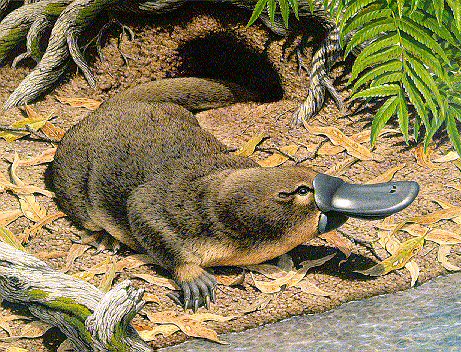Breaking News: Platypus – 120 M Yrs Old Living Fossil
Posted by: Loren Coleman on October 29th, 2007

When the platypus (Ornithorhynchus anatinus) was first discovered by Europeans in 1798, no one believed it could be real. British scientists were at first convinced it must be a hoax.
George Shaw, who produced the first description of the animal in 1799 in the Naturalist’s Miscellany, originally had his doubts about it being a real animal. Shaw cut up the dried skin to look for stitches. Robert Knox believed it may have been produced by some Oriental taxidermist by sewing a duck’s beak onto the body of a beaver-like animal.
How would have zoology and cryptozoology dealt with such an oddity today? One thing is for certain, the species remains an extraordinary animal, a mammal that lays eggs and has poisonous spurs.
Now, according to Discovery News’ Jennifer Viegas, “Platypuses may be older than we think,” having been here for 120 million years or more:
Researchers once suspected that platypus relatives emerged long after the great extinction event that wiped out the dinosaurs.
Now, they believe that platypus descendents, including those of their echidna relatives, go back to at least the Early Cretaceous period, possibly even earlier.
The Early Cretaceous is associated with the appearance and prominence of numerous dinosaur groups.
The key to the platypus puzzle is an ancient egg-laying mammal relative called Teinolophos trusleri, whose fossils have been collected over the past decade.
“It suggests that both the platypus and echidna lineages were distinct by 120 million years ago, and that the platypus, at least, has occupied its stable niche as an electro-receptive aquatic predator ever since,” says Professor Timothy Rowe, who announced the finding at the Society of Vertebrate Paleontology annual meeting in Austin, Texas.
* * *
A larger question is, how did such an unusual creature, with its venom, duck bill, beaver tail and otter-like feet, emerge in the first place? And how did it survive the devastating dinosaur extinction event?
Dr Kenneth Angielczyk, assistant curator of paleaomammalogy at The Field Museum in Chicago, says that the platypus might have benefited by the fact that it was not a top predator.
“Work that we’ve done so far suggests that poor competitors, ie, weedy species, have an advantage when disturbance strikes, perhaps because they can do a lot of different things to survive, but don’t do any of them well enough to be strong competitors under normal circumstances,” he says.
Angielczyk and colleagues also announced their research at the Society of Vertebrate Paleontology meeting.
They found that carnivore-rich, but herbivore-poor, animal communities tend to not fare as well as communities with a lot of plant eaters.
The former, which dominated the planet from around 318-270 million years ago, faded over time.
While the platypus is not a veggie-loving herbivore, it is now known that it squeaked past the mass extinction event.
“Maybe the platypus was just in the right place at the right time,” Angielczyk says.Discovery News, October 23, 2007.
About Loren Coleman
Loren Coleman is one of the world’s leading cryptozoologists, some say “the” leading living cryptozoologist. Certainly, he is acknowledged as the current living American researcher and writer who has most popularized cryptozoology in the late 20th and early 21st centuries.
Starting his fieldwork and investigations in 1960, after traveling and trekking extensively in pursuit of cryptozoological mysteries, Coleman began writing to share his experiences in 1969. An honorary member of Ivan T. Sanderson’s Society for the Investigation of the Unexplained in the 1970s, Coleman has been bestowed with similar honorary memberships of the North Idaho College Cryptozoology Club in 1983, and in subsequent years, that of the British Columbia Scientific Cryptozoology Club, CryptoSafari International, and other international organizations. He was also a Life Member and Benefactor of the International Society of Cryptozoology (now-defunct).
Loren Coleman’s daily blog, as a member of the Cryptomundo Team, served as an ongoing avenue of communication for the ever-growing body of cryptozoo news from 2005 through 2013. He returned as an infrequent contributor beginning Halloween week of 2015.
Coleman is the founder in 2003, and current director of the International Cryptozoology Museum in Portland, Maine.










Thanks great article!
Crocodiles, Sharks, Platypus!?!?!
I’m pretty sure what we’re looking at here is a juvenile Bigfoot 😉
In all seriousness, the Platypus is a remarkable animal that stands as an example as to the strangeness of mother nature. We should always think back on the creature to remind us that nature can throw the close-minded some wicked living curveballs.
I rather take it that God does indeed have a sense of humor. I live near several bodies of water, and mallards are plentiful. They bring a grin to my face as well. Theres something inherently funny about a duckbill…..
Well, I’ve thought for a long time that there was a close identification between the cynodonts and the monotremes. As in, one and the same, really.
Queztlquatldon and dimotrodon are long gone, but not the platypus and the echidna.